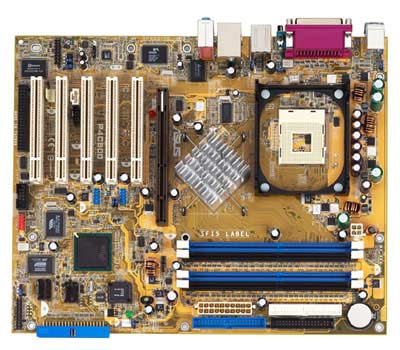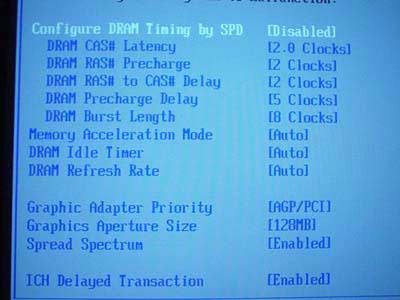865PE/875P Motherboard Roundup June 2003 - Part 1: 20-way Shootout
by Evan Lieb on June 12, 2003 10:57 PM EST- Posted in
- Motherboards
ASUS P4C800 Deluxe
|
Motherboard Specifications |
|
|
CPU
Interface
|
Socket-478
|
|
Chipset
|
Intel
82875P MCH (North Bridge)
Intel 82801EB ICH5 (South Bridge) |
|
Bus
Speeds
|
up
to 400MHz (in 1MHz increments)
|
|
Core
Voltages Supported
|
up
to 1.950V (in 0.0125V increments up to 1.60V, and 0.0250V after that)
|
|
I/O
Voltages Supported
|
N/A
|
|
DRAM
Voltages Supported
|
up
to 2.85V (in 0.05V increments)
|
|
Memory Slots
|
4 184-pin
DDR DIMM Slots
|
|
Expansion Slots
|
1 AGP
8X Slot
5 PCI Slots |
|
Onboard IDE RAID
|
Promise
PDC20378 controller (RAID 0, RAID 1 & RAID 0 + 1)
|
|
Onboard USB 2.0/IEEE-1394
|
Eight
USB 2.0 ports supported through South Bridge
VT6307 IEEE-1394 FireWire Controller |
|
Onboard LAN
|
3COM
3C940 Gigabit LAN (no CSA bus)
|
|
Onboard Audio
|
Analog
Devices AD1985 Controller
|
|
Onboard Serial ATA
|
Two
SATA connectors via ICH5 (no RAID)
Two SATA connectors via Promise PDC20378 Controller (RAID 0, RAID 1 & RAID 0 + 1) |
|
BIOS
Revision
|
1006
|

One of the most notable attributes of the P4C800 Deluxe is its IDE/Serial ATA drive support. As usual there are the standard IDE connectors, dubbed the Primary and Secondary IDE connectors, which support two channels each and therefore up to four IDE drives total. There's one additional IDE connector powered by the Promise PDC20378 controller. This specific Promise controller supports just two IDE channels, meaning a max of two hard drives (no optical drives allowed) can be connected. This same Promise PDC20378 controller also powers two Serial ATA connectors (not the two ICH5-bound Serial ATA connectors), which allows users to connect one SATA drive to each connector. All in all you should be able to connect four SATA and six IDE drives to this motherboard, though we can't imagine what desktop user would have the need for ten drives in one case as the heat, noise, and maintenance required would be quite severe. Though we have to admit, the P4C800 Deluxe's drive capability is perfect for small database workstations/servers and the like.

Not surprisingly the ASUS P4C800 Deluxe contains excellent overclocking options such as a Vcore available as high as 1.950V, VDIMM up to 2.85V in 0.5V increments and a FSB ceiling of 400MHz. All these options make it exceedingly easy for overclockers to take advantage of the P4C800 Deluxe's tremendous FSB overclocking ability. In fact, if you were to replace the P4C800 Deluxe's passive North Bridge heatsink with a good active cooling solution you'll probably be able to squeeze a good 290MHz FSB out of this motherboard. We would never have guessed 6 months ago that 300MHz FSB (1.2GHz effective) frequencies would be possible by summer.

Some of the negative aspects the P4C800 Deluxe carries are its lack of basic high-end features like ICH5R and CSA Gigabit LAN that all top-of-the-line 875P Pentium 4 motherboards should carry. Coincidently enough ASUS has just released a new version of the P4C800 Deluxe, dubbed the P4C800-E Deluxe. This new revision corrects some of the mistakes ASUS made with the original 875P revision we examined last April and are examining again today. The E revision tacks on native RAID support and CSA support, almost certainly because there has been demand for it. However the price premium being asked for the P4C800-E Deluxe simply isn't worth it when compared to other high-end motherboards on the market such as ABIT's IS7-G/IC7-G, Soyo's P4I875P DRAGON 2, Gigabyte's 8KNXP, and AOpen's AX4C Max.










18 Comments
View All Comments
Anonymous User - Thursday, July 24, 2003 - link
Could anyone clarify if the information for the sound system on the Abit IS7 is correct? The article lists it as being an Analog Devices AD1985. I thought it was Realtek?Thanks,
Harry
Anonymous User - Wednesday, July 23, 2003 - link
What a great article!We're waiting for the Part 2... :B
Evan Lieb - Monday, July 21, 2003 - link
I bet that the Part 1 thread would be posted by a certain date, and it was indeed posted on that date. I never anything about Part 2, because I've been thinking of adding more benchmarks and data in general to round out any and all Pentium 4 motherboard testing until Prescott arrives.Anonymous User #4, you should always research your recollections if you can't exactly "recall" certain events correctly. ;)
Evan Lieb - Monday, July 21, 2003 - link
Anonymous User - Friday, July 18, 2003 - link
As I recall, Evan made a bet on the part 2 being posted a while back.... the thread was mysteriously removed though.Anonymous User - Wednesday, July 16, 2003 - link
So, what month/year will part 2 be posted?Anonymous User - Sunday, July 6, 2003 - link
I read that the Epox 4pca3+ could do a 1,85 vcore with a bois update.. If anyone know where to find this bios update, please e-mail me zimen1@msn.comI really can't find it.
Anonymous User - Sunday, July 6, 2003 - link
I also fried my MSI 875P Neo-FIS2R when I updated the BIOS from 1.2 to 1.4. I got a replacement board, but have been hesitant to try again based on my prior experience. Based on your experience with 1.5, (and now 1.6 is available), I'm willing to take another chance.